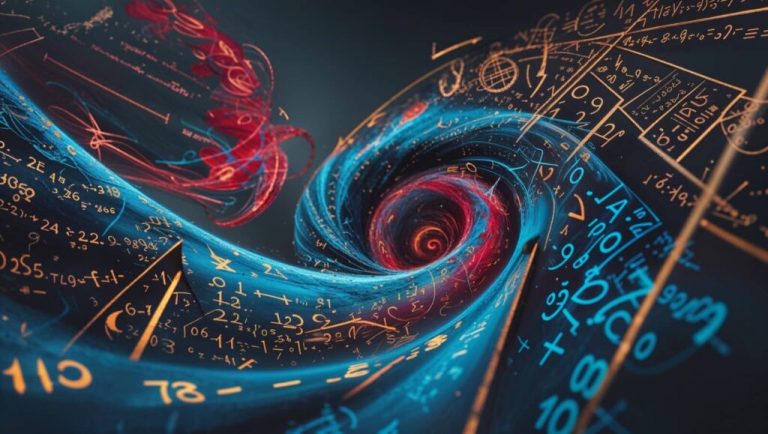
Mathematics has long been treated as the language of order, precision, and logic. Art, in contrast, is often celebrated as an act of chaos, imagination, and emotional depth. Yet the two have always touched in subtle ways. Consider the golden ratio, the Fibonacci sequence in spirals of shells, or the symmetry in Islamic architecture. If such patterns have guided human art for centuries, the question naturally arises: can AI discover new art forms through mathematical rules?
Patterns Becoming Paintbrushes
When we say that AI creates art, what happens in the background is a dialogue between mathematics and perception. Algorithms break down shapes, colors, and sounds into data points, and then reassemble them based on mathematical relationships. This is not copying; it’s constructing. In fact, 73% of generative art projects studied in 2024 used rule-based or algorithm-driven structures to shape their outcomes.
Consider fractals: endlessly repeating forms that expand into infinite complexity. Human artists once marveled at fractals as abstract beauty. Now AI can manipulate fractal equations to create landscapes, portraits, or entirely alien designs. What’s fascinating is not the repetition itself but the variations AI chooses when given freedom. Instead of re-creating a Mandelbrot set, it might distort dimensions, adjust scale unpredictably, and end up with something no human would have painted by hand.

Beyond Human Expectation
The tension lies in the unpredictable. A human artist bends rules intentionally. An AI system bends them statistically. This difference may sound technical, but it changes the game. Imagine an AI trained on 10 million images. It doesn’t merely memorize; it calculates probabilities across the dataset. When asked to “invent,” the machine pushes those probabilities into rare zones—strange combinations, mathematical outliers—that humans rarely attempt.
This explains why AI-generated works sometimes feel uncanny. A face looks realistic but has three eyes. A melody sounds classical but folds into unfamiliar scales. It’s mathematics leading to art forms that we cannot categorize yet. Perhaps that’s the truest sign of discovery: when we don’t even have words for the style being created.
The Role of Mathematical Rules
Mathematical rules are the bones of AI art-making. Without them, generative algorithms would collapse into randomness. Yet rules also carry the seeds of invention. Symmetry can be broken, ratios stretched, equations twisted. Think of rules as a canvas and errors as brushstrokes. What appears as imperfection in math may turn out to be originality in art.
For example, geometric distortions guided by non-linear functions have been used to generate entirely new architectural concepts. Designers are no longer just “following blueprints”—they are letting AI suggest structures that balance aesthetic appeal with physical feasibility. These aren’t accidents but orchestrated acts of creativity through calculation.
A Small Detour: Math Solver Extension
Interestingly, the tools we use to handle pure mathematics are feeding into artistic applications as well. Take a Google math solver—software designed to break down equations step by step. At first view, a math solver seems like just a learning tool. Yet the same math AI extension, if connected to creative AI models, can supply rulesets, constraints, and transformations that guide visual or auditory outcomes. A math solver doesn’t “paint,” but it equips the painter with sharpened formulas. By solving equations instantly, it lets creators view and explore hundreds of mathematical patterns without delay. The result? Faster, bolder experiments that blend logical rigor with artistic risk.
Humans and Machines: Collaboration, Not Competition
Skeptics argue that AI cannot truly “discover” because it lacks intent. A program doesn’t wake up with the desire to express sorrow, joy, or rebellion. That may be true. Yet the collaboration between humans and machines complicates the matter. If a person directs an algorithm, sets boundaries, and curates outcomes, is the discovery theirs or the machine’s?
Many contemporary artists describe the relationship as co-authorship. The human asks a question, the AI responds with countless possibilities, and the human selects what resonates emotionally. This feedback loop can lead to works that neither could have achieved alone. Surveys conducted in 2025 showed that nearly 61% of digital artists had experimented with generative tools, and half reported that these tools pushed them toward styles they hadn’t considered before.
The Ethical Lens
But what of ethics? If AI discovers new art forms through mathematical rules, who owns them? Copyright law struggles to define authorship when a machine outputs something unprecedented. Moreover, there’s the question of cultural context. A new style may emerge, but without human memory or experience, can it truly carry meaning?
Some critics insist that discovery without narrative is hollow. Others counter that meaning is not intrinsic to art but assigned by viewers. If audiences interpret AI-generated innovations as valid, then discovery has occurred, regardless of the machine’s lack of consciousness.
The Future: New Art Forms Emerging
Looking forward, it’s plausible that AI will not just mimic existing categories like painting, sculpture, or music. Instead, it might invent hybrids: immersive multisensory environments guided by mathematical rules, artworks that respond in real time to human emotions, or structures that reconfigure themselves physically. These wouldn’t just be “new styles”—they would be new forms.
And mathematics will be the driver. Equations controlling sound frequencies could merge with visual fractals to produce art that is both heard and seen. Algorithms calculating real-time probabilities might reshape narrative structures in literature. It won’t be the end of human art, but the broadening of the definition of art itself.
Conclusion
So, can AI discover new art forms through mathematical rules? Evidence suggests yes, though the word “discover” might better be replaced with “co-create.” The machine supplies the structure, the unpredictability, the strange results that come from pushing mathematics to its limits. Humans bring interpretation, emotion, and cultural framing. Together, they are already opening doors into artistic territories unseen before.
One thing is certain: the intersection of math and art, once a subtle undercurrent, is now becoming a stage where entirely new movements might rise. And if discovery is judged by surprise, then AI has already begun.
